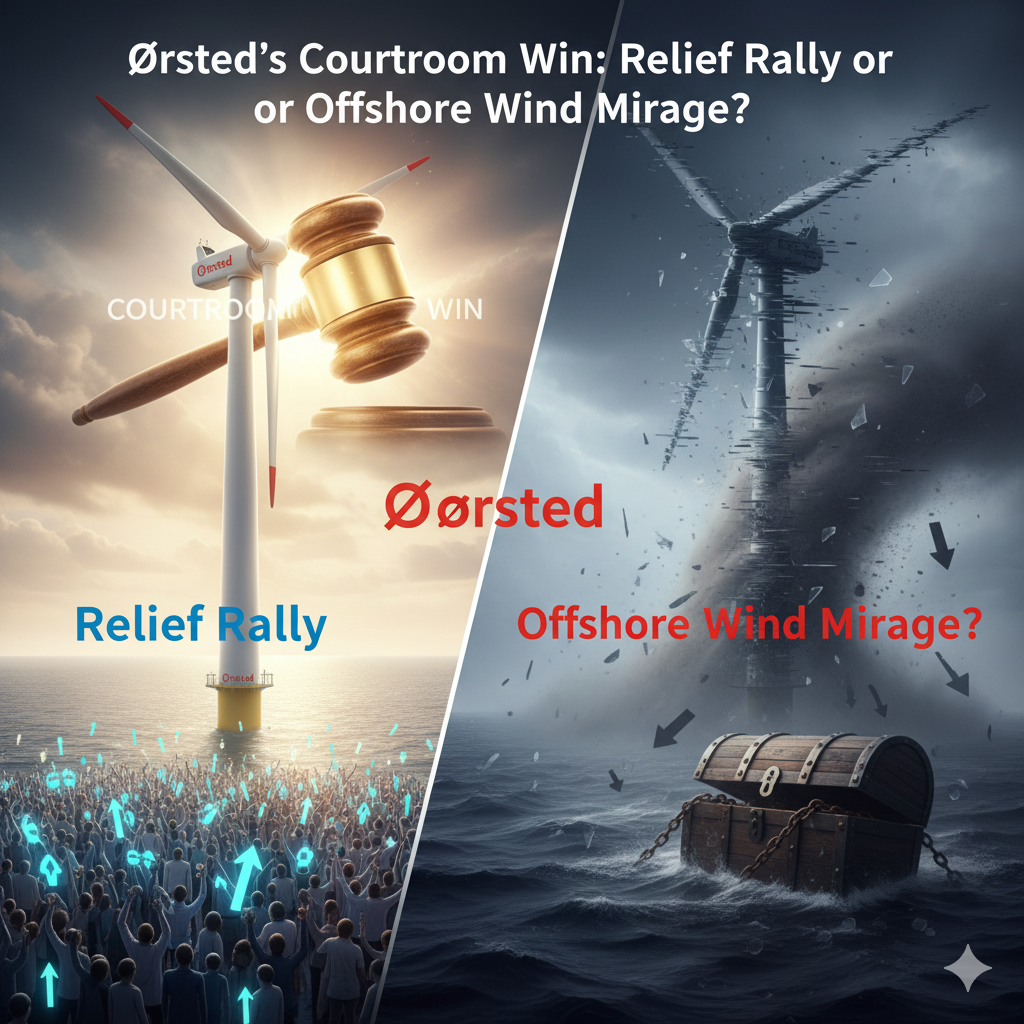Ørsted’s Courtroom Win: Relief Rally or Offshore Wind Mirage?
Ørsted (ORSTED.CO) shares jumped after a U.S. court revived its $5B Revolution Wind project, averting $1B+ in losses. The ruling eases near-term risk but political uncertainty, cost inflation, and sector-wide PPA strains mean the stock’s bounce looks more like relief than re-rating.

Ørsted’s (ORSTED.CO) shares spiked ~5% after a U.S. federal judge lifted a Trump-era stop-work order on the Revolution Wind project off Rhode Island and Connecticut — a project that had been 80% complete before construction was halted. The ruling, which grants a preliminary injunction, allows work to resume immediately, avoiding what Ørsted warned could have been billions in sunk losses and years of delay.
The court’s reasoning was economic as much as procedural. Ørsted and partner Skyborn Renewables demonstrated daily delay costs of ~$2.3 million and highlighted that the specialized offshore construction vessel — critical for turbine installation — would not be available again until 2028 if missed this fall. With ~$5 billion already committed, the court accepted the argument of “irreparable harm” if work did not resume.
For investors, the decision stabilizes Ørsted’s near-term risk profile. The company had faced potential impairments exceeding $1 billion if Revolution Wind were canceled, at a time when its balance sheet is already stretched by U.S. project write-downs and European cost inflation. Ørsted has struggled with offshore wind profitability in recent years: rising turbine prices, higher interest rates, and supply chain bottlenecks shaved its EBITDA margins and pressured its credit metrics. The resumption of Revolution Wind removes one acute downside risk and restores visibility on ~704 MW of capacity, expected to power 350,000 homes once operational.
The political overlay, however, remains a key variable. The Trump administration has positioned offshore wind as a target, citing national security concerns, and the Bureau of Ocean Energy Management (BOEM) continues its investigation even as work resumes. A final ruling against the project remains possible, meaning equity markets will likely price Revolution Wind at a risk-adjusted discount until commercial operation is secured.
Relative to peers, Ørsted now regains some momentum. U.S. offshore projects backed by Equinor (EQNR) and BP (BP) have also faced permitting delays, renegotiated PPAs, and cost inflation. Meanwhile, European rivals like RWE (RWE.DE) and Vestas (VWS.CO) are contending with similar margin pressures but less exposure to U.S. regulatory swings. For Ørsted, Revolution Wind’s revival bolsters its North American pipeline credibility, even as future projects remain hostage to political cycles.
Valuation remains fragile. Ørsted’s market cap, at ~$35 billion, has fallen sharply from 2021 highs as the stock derated alongside higher rates and offshore wind overruns. A 5% bounce reflects relief, not re-rating. Sustained upside will depend on (i) completion of Revolution Wind on schedule and budget, (ii) stabilization of U.S. federal policy post-2024 elections, and (iii) evidence that Ørsted can secure better contract terms in future auctions to offset rising turbine and financing costs.
For the broader U.S. offshore wind sector, the ruling matters symbolically. If projects already 80% complete can be halted for political reasons, investor appetite for long-dated PPAs will remain fragile. Developers and financiers will demand higher risk premia, which could slow progress toward Biden-era targets even if individual rulings go developers’ way.
In short, the injunction gives Ørsted breathing room — but it doesn’t erase structural pressures on the offshore wind sector. Investors may treat the stock’s bounce as a tactical relief rally, not yet a fundamental turnaround. Revolution Wind is now a test case: if it reaches operation, it will signal resilience of offshore wind economics under hostile political conditions. If not, Ørsted risks reinforcing the market’s skepticism about whether offshore wind can deliver sustainable returns in the U.S.





